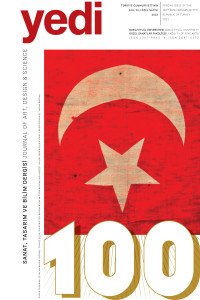Araştırma Makaleler
Derleme Makaleler
Aim & Scope
yedi aims to publish original articles within the disciplines of fine arts which contribute to the literature.
yedi accepts articles in the areas of art and design, as well as articles on art and design in humanities, social sciences, applied sciences and natural sciences. Multi-disciplinary articles such as in cultural studies and communication studies are also welcome.
yedi especially promotes interdisciplinary articles written by authors from different disciplinary backgrounds (humanities and sciences) in collaboration with authors from disciplinary backgrounds in art and design. However, interdisciplinarity is not compulsory.
Author Guidelines
The purpose of these guidelines, based on the American Psychological Association (APA) 7th Edition, is to ensure a clear, standard format for yedi submissions. Please follow all guidelines as closely as possible.
1. yedi Article Template: Articles should be formatted according to the yedi article template which can be downloaded from the website. Yedi Article Template
2. Abstract: The abstract should be 150-300 words long. Footnotes and citations are not permitted.
3. Keywords: 3-9 words.
4. Main Text: The main text should be 3.500-7.000 words long.
5. Figures and Tables: Figures and tables should be numbered and include concise, self-explanatory captions, and should be embedded within the main text. Authors are responsible for formatting. Figures should be camera-ready. For the print version of the journal, figures should be black and white unless their content makes color unavoidable and the author(s) meets any additional printing costs. First authors are responsible for any copyright issues. Digital files of figures and illustrations should be also delivered separately in .TIF or .JPG format with a minimum resolution of 300 dpi. Freehand or typewritten lettering should not be used.
6. Footnotes: Footnotes should be numbered and be less than 60 words.
7. Quotations: All quotations should be cited. For quotations of fewer than 40 words, add quotation marks around the words and incorporate the quote into your own text— no additional formatting is needed. Quotations of 40 words or more should be formatted as block quotations. Do not use quotation marks to enclose a block quotation.
8. In-Text Citation:
see https://apastyle.apa.org/style-grammar-guidelines/references/elements-list-entry#retrieval
APA Style uses the author–date citation system, in which a brief in-text citation directs readers to a full reference list entry. The in-text citation appears within the body of the paper (or in a table, figure, footnote, or appendix) and briefly identifies the cited work by its author and date of publication. This enables readers to locate the corresponding entry in the alphabetical reference list at the end of the paper. Each work cited must appear in the reference list, and each work in the reference list must be cited in the text (or in a table, figure, footnote, or appendix).
One author
Parenthetical citation: (Luna, 2020)
Narrative citation: Luna (2020)
Two authors
Parenthetical citation: (Salas & D’Agostino, 2020)
Narrative citation: Salas and D’Agostino (2020)
Three or more authors
Parenthetical citation: (Martin et al., 2020)
Narrative citation: Martin et al. (2020)
9. References
see https://apastyle.apa.org/style-grammar-guidelines/references/
Journal article
Grady, J. S., Her, M., Moreno, G., Perez, C., & Yelinek, J. (2019). Emotions in storybooks: A comparison of storybooks that represent ethnic and racial groups in the United States. Psychology of Popular Media Culture, 8(3), 207–217. https://doi.org/10.1037/ppm0000185
Whole authored book
Jackson, L. M. (2019). The psychology of prejudice: From attitudes to social action (2nd ed.). American Psychological Association. https://doi.org/10.1037/0000168-000
Sapolsky, R. M. (2017). Behave: The biology of humans at our best and worst. Penguin Books.
Whole edited book
Kesharwani, P. (Ed.). (2020). Nanotechnology based approaches for tuberculosis treatment. Academic Press.
Torino, G. C., Rivera, D. P., Capodilupo, C. M., Nadal, K. L., & Sue, D. W. (Eds.). (2019). Microaggression theory: Influence and implications. John Wiley & Sons. https://doi.org/10.1002/9781119466642
Chapter in an edited book
Aron, L., Botella, M., & Lubart, T. (2019). Culinary arts: Talent and their development. In R. F. Subotnik, P. Olszewski-Kubilius, & F. C. Worrell (Eds.), The psychology of high performance: Developing human potential into domain-specific talent (pp. 345–359). American Psychological Association. https://doi.org/10.1037/0000120-016
Dillard, J. P. (2020). Currents in the study of persuasion. In M. B. Oliver, A. A. Raney, & J. Bryant (Eds.), Media effects: Advances in theory and research (4th ed., pp. 115–129). Routledge.
10. Audiovisual Media: Please refer to the link below.
https://apastyle.apa.org/style-grammar-guidelines/references/examples/#audiovisual-media
Ethical Principles and Publication Policy
Ethical Principles
The editorial board puts special emphasis on the prevention of conflicts of interest that may arise between authors and editors, authors and reviewers, and all article evaluation forms have been prepared with the necessary warnings in line with this principle. In this sense, the recommendations of ICMJE (http://www.icmje.org/) (International Committee of Medical Journal Editors) and the International Standards for Editors and Authors of COPE (https://publicationethics.org/resources/resources-and-further-reading/international-standards-editors-and-authors) (Committee on Publication Ethics) are taken into consideration for article proposals.
Article proposals must comply with copyright regulations for intellectual and artistic works, as indicated in the copyright form.
Separate ethics committee approval must be obtained for research in all disciplines, including social sciences, and for clinical and experimental studies on human and animals that require ethics committee approval, and this approval must be stated and documented in the article.
Publication Policy
Yedi is an open access journal. Authors are not charged any fees for article submission, review or publication, and readers have free access to the journal's electronic publication.
The Open Access Policy of the journal Yedi adopts the principles outlined by the Budapest Open - Access Initiative (BOAI).
https://kutuphane.deu.edu.tr/yayinevi/journals_tr.html
https://kutuphane.deu.edu.tr/yayinevi/journals_en.html
Price Policy
Authors are not charged any fees for submission, review or publication, and readers can access the electronic version of the journal free of charge.
